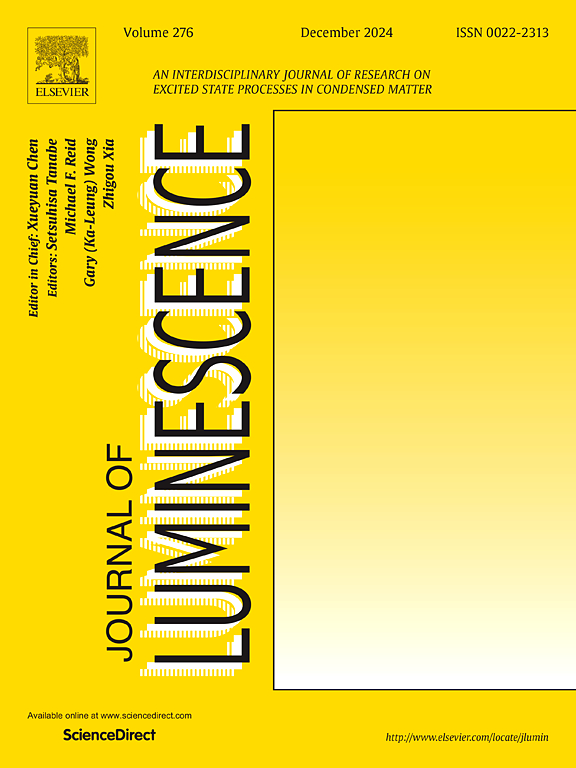Tb3+活化碲酸盐微晶玻璃的合成及闪烁性能
IF 3.6
3区 物理与天体物理
Q2 OPTICS
引用次数: 0
摘要
在本研究中,通过构建Gd3+- Tb3+能量转移体系,成功制备了含有BaGdF5纳米晶的Tb3+掺杂碲-锗酸盐微晶玻璃。系统地研究了其显微结构和光学性能。通过DTA、XRD、SEM等表征技术,确定了最佳热处理条件为880℃、1 h,在此条件下,BaGdF5纳米晶在玻璃基体中均匀析出。在378 nm紫外光激发下,玻璃陶瓷在545 nm处显示出强烈的绿色发光,发光强度比前驱体玻璃高约100%。x射线激发发光(XEL)测试表明,与商业BGO晶体相比,优化后的微晶玻璃实现了72.6%的积分发射强度。此外,样品表现出优异的辐射稳定性,在连续x射线照射180分钟后,发光强度仅下降20%。本研究证实了Tb3+掺杂碲-锗酸盐玻璃陶瓷具有高发光效率和优异的耐辐射性能,在慢事件x射线检测中具有重要的应用潜力。本文章由计算机程序翻译,如有差异,请以英文原文为准。
Synthesis and scintillation properties of Tb3+-Activated tellurite glass-ceramics
In this study, Tb3+-doped tellurite-germanate glass-ceramics containing BaGdF5 nanocrystals were successfully fabricated via the construction of a Gd3+- Tb3+ energy transfer system. The microstructure and optical properties were systematically investigated. Through characterization techniques including DTA, XRD, and SEM, the optimal heat treatment condition was determined to be 880 °C for 1 h, under which BaGdF5 nanocrystals homogeneously precipitated in the glass matrix. Under 378 nm ultraviolet excitation, the glass-ceramics exhibited intense green emission at 545 nm, with a luminescence intensity approximately 100 % higher than that of the precursor glass. X-ray excited luminescence (XEL) tests revealed that the optimized glass-ceramics achieved an integral emission intensity of 72.6 % compared to a commercial BGO crystal. Moreover, the sample demonstrated excellent radiation stability, with only a 20 % decrease in luminescence intensity after 180 min of continuous X-ray irradiation. This study confirms that the Tb3+-doped tellurite-germanate glass-ceramics combine high luminescence efficiency with superior radiation resistance, showing significant potential for applications in slow-event X-ray detection.
求助全文
通过发布文献求助,成功后即可免费获取论文全文。
去求助
来源期刊

Journal of Luminescence
物理-光学
CiteScore
6.70
自引率
13.90%
发文量
850
审稿时长
3.8 months
期刊介绍:
The purpose of the Journal of Luminescence is to provide a means of communication between scientists in different disciplines who share a common interest in the electronic excited states of molecular, ionic and covalent systems, whether crystalline, amorphous, or liquid.
We invite original papers and reviews on such subjects as: exciton and polariton dynamics, dynamics of localized excited states, energy and charge transport in ordered and disordered systems, radiative and non-radiative recombination, relaxation processes, vibronic interactions in electronic excited states, photochemistry in condensed systems, excited state resonance, double resonance, spin dynamics, selective excitation spectroscopy, hole burning, coherent processes in excited states, (e.g. coherent optical transients, photon echoes, transient gratings), multiphoton processes, optical bistability, photochromism, and new techniques for the study of excited states. This list is not intended to be exhaustive. Papers in the traditional areas of optical spectroscopy (absorption, MCD, luminescence, Raman scattering) are welcome. Papers on applications (phosphors, scintillators, electro- and cathodo-luminescence, radiography, bioimaging, solar energy, energy conversion, etc.) are also welcome if they present results of scientific, rather than only technological interest. However, papers containing purely theoretical results, not related to phenomena in the excited states, as well as papers using luminescence spectroscopy to perform routine analytical chemistry or biochemistry procedures, are outside the scope of the journal. Some exceptions will be possible at the discretion of the editors.
 求助内容:
求助内容: 应助结果提醒方式:
应助结果提醒方式:


